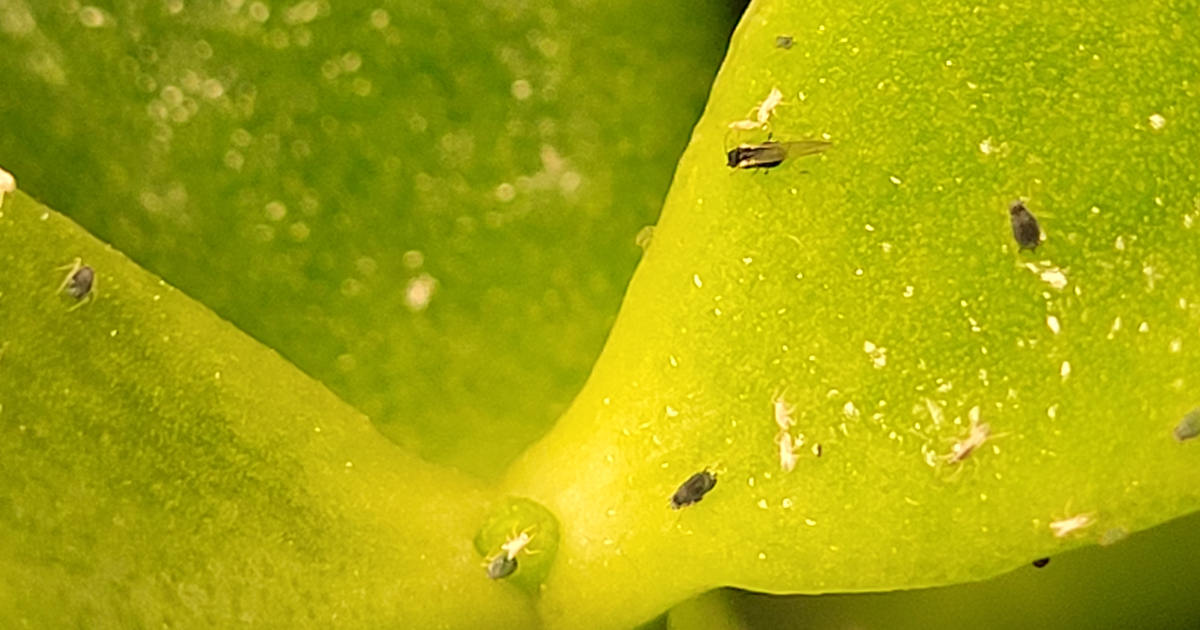Houseplant Pest Spotlight: Aphids
Many houseplant pests, including aphids, are common but there are steps you can take to eliminate the pests and protect your plants.
Recently, I spotted small, black bugs crawling around on my jade plant (Crassula ovata). I immediately quarantined the plant and set about identifying the pest. I suspected aphids since I could see them and they were found on another houseplant recently. However, making an accurate houseplant pest ID ensures a better chance of dealing with it correctly.
Plant Condition
Aphids use their straw-like mouthparts to suck plant juices from the leaves which can cause leaf yellowing and stunting of new shoots. Fortunately, my plant still looks healthy, with new growth and no signs of yellowing.
Insect Appearance
Aphids are small, as you can see in the cellphone photo above, zoomed in at 1.5x. There are many species of aphids but they’re all soft-bodied and have a pear shape. On my jade plant, they are gray and black but aphids can be yellow, brown, green, or pink. In addition, some aphids have a wooly or waxy appearance.
Adult aphids may or may not have wings, depending on the species and level of infestation. It was difficult to tell if the insects on my plant had wings until I used a magnification work light, shown in the image below.
Aphids on my jade plant as viewed under magnification work light.
In addition to the lighter-colored nymphs, I could see white bits on the leaves. Before becoming adults, nymphs (young aphids) will molt about four times leaving their white skins behind.
However, there’s no sign of honeydew (clear, sticky aphid poo) on the leaves. If present, honeydew can attract ants or cause mold.
Insect Location
I found the insects mostly on the young, upper portion of the jade, both on the top and underneath the leaves. This is primarily where aphids hang out on a plant because they prefer the juices of tender new growth.
Aphids as seen with my DSLR camera and macro lens.
Pest Control
Aphids multiply rapidly. Females can reproduce sexually and lay eggs or asexually and give birth to live female young. Within the first week of life, the nymph will go through four molts to become an adult aphid. During ideal conditions, she can then generate up to eighty more live young the following week (UC IPM). Because of this, it’s important to take action quickly before a large aphid population can do irreparable damage to your houseplant.
A good first step to controlling aphids on houseplants is to spray the plant and insects with water. The spray should be as strong as possible without damaging the plant. Don’t forget to spray the underside of the leaves. In my case, the jade can handle a good spray so that knocked off most of the insects.
After that, I decided to use rubbing alcohol on a cotton swab to dab the remainder of the visible aphids. Alcohol can damage the leaves of some plants so test before using it in larger quantities on your plant. My jade wasn’t harmed by the alcohol so I’ll keep doing spot treatments over the next couple of weeks as I see insects until they’re completely gone.
Other aphid treatments include insecticidal soaps, Neem oil (works slowly), Imidacloprid, and pyrethroid insecticides (CSU Extension). These can be purchased at a local garden center. Be sure to read the label and follow instructions for safety and to prevent damage to your plant. Biological controls, such as ladybugs or lacewings, are not practical for houseplants.
Prevention
As a final step, closely inspect all other houseplants for aphids and treat them accordingly. Check for houseplant pests often as part of your care routine to catch infestations early.
A good practice is to carefully inspect and quarantine new plants for a couple of weeks. This aphid outbreak was a result of a previous infestation on a new plant that wasn’t properly quarantined. I checked all the houseplants a couple of times but I didn’t keep up with it as I should have. I won’t be making that mistake again!


